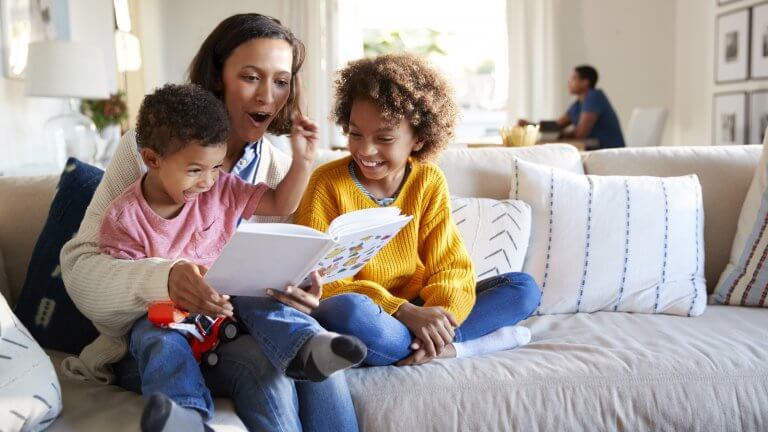Reading comprehension happens when your child extracts meaning from what they’ve read. It’s the primary goal of reading and a crucial part of your child’s longterm development. Even experienced teachers struggle finding and implementing reading comprehension strategies because the process is both interactive and strategic.
Due to COVID-19 you’re likely dealing with some form of having your kids at home while you work. To make things even harder you’re unable to hit up your normal engagement places (think museums, the zoo, and other places you love to go with your kids, but are now seeming like germ factories), so you may find yourself a little stir-crazy.
Now is a great time to work on developing your child’s reading comprehension. You can use these tips and tricks to help guide their reading. They’re easy to implement by anyone with age appropriate books and they’ll help put those little minds to work while schools are currently closed.
Reading Comprehension Strategy #1: Before you start reading a book, tell you child WHY you’re reading the book.
If you don’t have a background in education, this is going to sound a little abstract. But it’s very important! To understand this concept better, thinking about going to a movie theater – can you imagine going to a horror movie without knowing it’s going to have some scary moments? Or, what if you were expecting to see a comedy, only to figure out about halfway through the movie that it’s a documentary?
Our brains process information based on what we’re trying to get out of it. So, if the book you’re reading to your child is simply a fun story, tell them that. If it’s a non-fiction text with a specific subject (ex: a book about birds), tell them that! Keep in mind that it can be helpful to read whatever story you’ll be sharing with your child before you read it to them. This gives you the opportunity to frame the story in a way they will better understand.
Let’s start with two reading purposes: reading to entertain (most fiction text), and reading to learn (most nonfiction text). Here are some sentence frames that can help with this version of reading comprehension. Before starting a book with your child, find one that works for the book you’re going to read with them, and fill in the blank where necessary.
Parent/reader = P
Child/student = C
Sentence frames for fiction text (reading to entertain):
- “This book is a story about _______.”
- “The main character in this story is ______.”
- “In this story, the main character has a problem! Let’s read together to find out how they solve it.”
Sentence frames for non fiction text (reading to learn):
- “This is a book that will teach us about _______.”
- “What do you already know about ________? Let’s read this book to find out more.”
- “Have you ever wanted to know more about _______? Let’s see if we can discover something new about ________ in this book.”
The sentence frames above are just a start. If you have other ideas, go for it! The important thing is this: make sure your kids know WHY they are reading before the book starts.
Reading Comprehension Strategy #2: Ask questions before, during, and after you read.
When reading with your child, it’s natural for questions to come up. While some children keep questions to themselves, others ask so many that as a parent, it can feel like you’re doing more question-answering than book-reading! In fact, questions that come up while reading a book are a great indication that a child is both interested in the content of the book, and that they are comprehending the content of the book.
The next time you read a book with your child, try using the following sentence before beginning:
“While we’re reading this book, we’re going to practice asking questions about (the story/what we’re learning). I might ask you some questions about what you think, and I want you to ask me some questions about what you are wondering about. Does that sound good to you?”
When it comes to asking questions, use some of the question starters below to model good questioning with your child. If this is new to them (or to you!), pick one and take turns using it throughout the book.
Question starters (open-ended):
- “I wonder why…”
- “Why do you think…”
- “What do you think is the reason that…”
Question starters (for specific details):
- “Can you show me where…” – this one works especially well with picture books
- “Who (insert action or detail) ? Why did they (insert action or detail)?
- ex: Who went to the park? Why did they go to the park?
- “What did you learn about _________ on this page?”
Once children are comfortable asking questions, you may find yourself surprised at how many questions they have while being read to. If the amount of questions starts to affect their (or your) ability to follow the storyline or content of the book you’re reading, encourage them to keep their questions to themselves until you get to a good stopping place.
Reading Comprehension Strategy #3: Make predictions with your child
We make predictions all the time. We predict what the traffic will be like on the way to work, what the weather will be like on a given day, and, whether we realize it or not, we make predictions when we are reading. In fact, the ability to make logical predictions, whether they turn out to be true or not, is a great way to gauge reading comprehension in your child.
The next time you read a book with your child, try using the following introduction before beginning:
“This is the book we’re going to read together. It’s called ___________. Take a look at the cover, the pictures (if relevant), and take about 10 seconds to flip through some of the pages. Then, tell me your prediction for what this story will be about.”
While reading the book, stop every once in a while to ask your child one of the following questions:
- What do you think is going to happen next? (for fiction text or narrative text)
- This section is about __________. What do you predict we will learn? (nonfiction or informational text)
- ex: (book about lizards) “This section is about what lizards eat. What do you think we we learn?
As with any strategy, these reading comprehension strategies are just the beginning. The best thing you can do for your child is to continue practicing these skills and continue reading with them. As you practice these skills more and more, you’re sure to see your child’s reading comprehension improve!
Download a copy of our Reading Comprehension Sentence Stems for Parents for free
Seth Herrington is the project coordinator for our product development team here at the Education Service Center Region 13.





Do you happen to have the Reading Comprehension Sentence Stems for Parents in Spanish? If so, where could I get them? Thanks so much!
Hi Karen,
We are currently working on that, and we’ll let you know when it’s available.
Thanks!
Hey Karen,
Thanks for reaching out to us with this! We’ve translated this same resource to Spanish, you can access that here: http://esc13.info/readingcomp-spanish